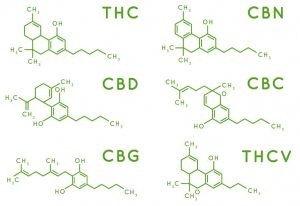We are often asked what the difference is between full-spectrum and isolate based CBD products. We’ll elude to provide a simple, yet detailed explanation, in which one can be well informed with scientific facts and evidence.
The Cannabis sativa L. plant itself as well as preparations, have documented use by humans preceding back over 5,000 years. It is from these original landrace varieties that have been selected and bred for countless generations, that provide the diversity of genetic cannabinoid and terpene abundant cultivars which we grow today.
One of the current and most prominent debates (though, there is nothing to debate) regarding the efficacy of CBD products is full-spectrum CBD based products versus isolate CBD based products. Let’s get down to the brass tacks.
Full-spectrum CBD is characterized by over 500 hundred diverse plant compounds ( Pertwee R. ed. Handbook of Cannabis. Oxford University Press; 2014) which constitute an array of molecular shapes and sizes that interact with both the human body (and all other mammals), as well as with one another. Some of the more familiar compounds found in hemp as well as all plant species include 23 flavenoids (predominant in fruits and vegetables), 18 amino acids, 11 proteins and enzymes, 43 simple and fatty acids, 120 terpenoids, and a variety of anti-oxidants (M.A. ElSohly, D. Slade, Chemical constituents of marijuana: The complex mixture of natural cannabinoids. Life Sciences 78 (2005) 539–548). Included alongside these of course are the attributable cannabinoids which encompass over 100 distinct types, most popularly CBD, THC, CBN, CBG, and CBC. It is this diversification of molecular compounds that give full-spectrum CBD its well deserved title, and support the term “entourage effect” or “synergistic effect” that is believed to occur only with full-spectrum products. This is exactly the hemp plant CBD extract that we make and use directly in all of our products.
Inverse to full-spectrum CBD extract, is CBD isolate (single molecule CBD). This is precisely what it sounds like, simply just the CBD molecule that results from post plant extraction processing that expunges all the other plant compounds previously noted above. Additionally, CBD isolate can AND IS now also synthetically manufactured. CBD isolate is designated as a powder associated by its characteristic pure white color in its purest form, and is both odor and tasteless. There is no synergistic or entourage effect from isolate based products. Despite the stark differences between full-spectrum and isolate CBD based products, isolate has it’s place, particularly for those concerned about drug tests and can’t consume THC in even the smallest amounts.
Although the jury is still in recess regarding the data-driven categorical effectiveness of the entourage effect, a recent meta-analysis systematic review article investigated the resulting clinical data from a total of 11 medical center studies contrasting the efficacy of CBD-Rich extracts and purified (isolate) CBD (Pamplona FA, da Silva LR and Coan AC (2018) Potential Clinical Benefits of CBD-Rich Cannabis Extracts Over Purified CBD in Treatment-Resistant Epilepsy: Observational Data Meta-analysis. Front. Neurol. 9:759. doi: 10.3389/fneur.2018.00759 ). Both CBD types were administered and both showed improvements in patient episodes, “There was a higher number of patients reporting improvement after using CBD-rich Cannabis extracts (318/447, 71%) than those treated with purified CBD (81/175, 46%)”. However, the most striking and notable results observed was the amount of CBD needed. “The average daily dose reported for purified CBD was 25.3 mg/kg/day, while the average daily dose of CBD equivalent reported for CBD-rich Cannabis extract was merely 6.0 mg/kg/day.”, which is over 4 times lower.






